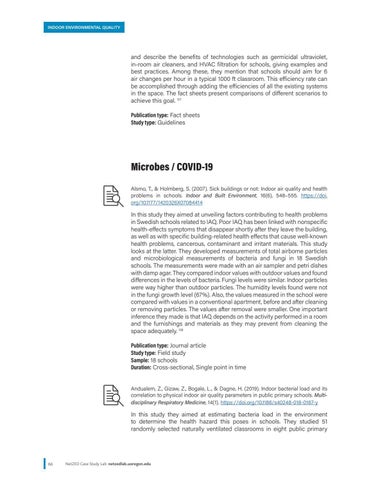INDOOR ENVIRONMENTAL QUALITY
and describe the benefits of technologies such as germicidal ultraviolet, in-room air cleaners, and HVAC filtration for schools, giving examples and best practices. Among these, they mention that schools should aim for 6 air changes per hour in a typical 1000 ft classroom. This efficiency rate can be accomplished through adding the efficiencies of all the existing systems in the space. The fact sheets present comparisons of different scenarios to achieve this goal. 117 Publication type: Fact sheets Study type: Guidelines
Microbes / COVID-19 Alsmo, T., & Holmberg, S. (2007). Sick buildings or not: Indoor air quality and health problems in schools. Indoor and Built Environment, 16(6), 548–555. https://doi. org/10.1177/1420326X07084414
In this study they aimed at unveiling factors contributing to health problems in Swedish schools related to IAQ. Poor IAQ has been linked with nonspecific health-effects symptoms that disappear shortly after they leave the building, as well as with specific building-related health effects that cause well-known health problems, cancerous, contaminant and irritant materials. This study looks at the latter. They developed measurements of total airborne particles and microbiological measurements of bacteria and fungi in 18 Swedish schools. The measurements were made with an air sampler and petri dishes with damp agar. They compared indoor values with outdoor values and found differences in the levels of bacteria. Fungi levels were similar. Indoor particles were way higher than outdoor particles. The humidity levels found were not in the fungi growth level (67%). Also, the values measured in the school were compared with values in a conventional apartment, before and after cleaning or removing particles. The values after removal were smaller. One important inference they made is that IAQ depends on the activity performed in a room and the furnishings and materials as they may prevent from cleaning the space adequately. 118 Publication type: Journal article Study type: Field study Sample: 18 schools Duration: Cross-sectional, Single point in time Andualem, Z., Gizaw, Z., Bogale, L., & Dagne, H. (2019). Indoor bacterial load and its correlation to physical indoor air quality parameters in public primary schools. Multidisciplinary Respiratory Medicine, 14(1). https://doi.org/10.1186/s40248-018-0167-y
In this study they aimed at estimating bacteria load in the environment to determine the health hazard this poses in schools. They studied 51 randomly selected naturally ventilated classrooms in eight public primary
66
NetZED Case Study Lab netzedlab.uoregon.edu

